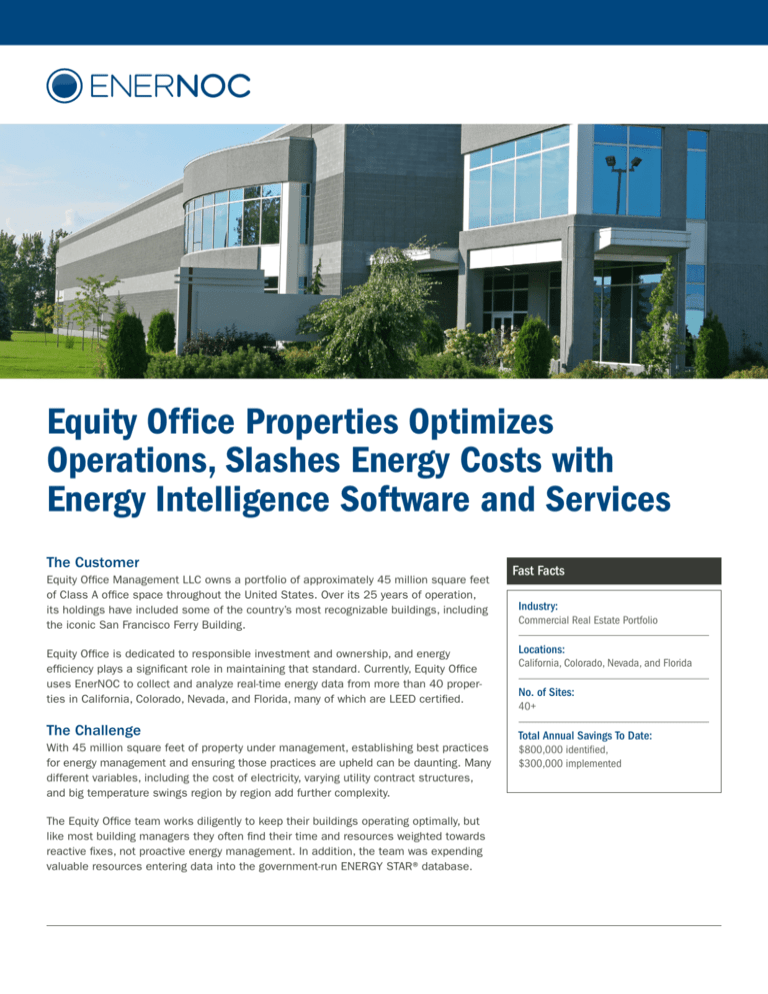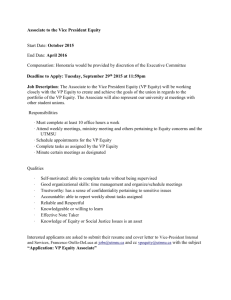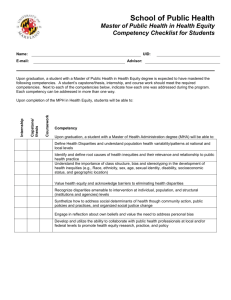
Equity Office Properties Optimizes
Operations, Slashes Energy Costs with
Energy Intelligence Software and Services
The Customer
Equity Office Management LLC owns a portfolio of approximately 45 million square feet
of Class A office space throughout the United States. Over its 25 years of operation,
its holdings have included some of the country’s most recognizable buildings, including
the iconic San Francisco Ferry Building.
Equity Office is dedicated to responsible investment and ownership, and energy
efficiency plays a significant role in maintaining that standard. Currently, Equity Office
uses EnerNOC to collect and analyze real-time energy data from more than 40 properties in California, Colorado, Nevada, and Florida, many of which are LEED certified.
The Challenge
With 45 million square feet of property under management, establishing best practices
for energy management and ensuring those practices are upheld can be daunting. Many
different variables, including the cost of electricity, varying utility contract structures,
and big temperature swings region by region add further complexity.
The Equity Office team works diligently to keep their buildings operating optimally, but
like most building managers they often find their time and resources weighted towards
reactive fixes, not proactive energy management. In addition, the team was expending
valuable resources entering data into the government-run ENERGY STAR® database.
Fast Facts
Industry:
Commercial Real Estate Portfolio
Locations:
California, Colorado, Nevada, and Florida
No. of Sites:
40+
Total Annual Savings To Date:
$800,000 identified,
$300,000 implemented
The Solution
The Results
Equity Office began using real-time energy data to better manage
their energy spend in 2005. They enrolled several New York
and New England properties in local demand response (DR)
programs, giving them access to streaming usage data at each
site. Although the DR payments were a much-welcomed revenue
stream, they realized the potential for far greater savings.
To date, EnerNOC has identified energy efficiency measures
(EEMs) that will total more than $800,000 in annual savings
across Equity Office’s portfolio. Equity Office’s team has already
implemented an impressive $300,000 of these identified
savings, recognizing that they maximize return on investment
(ROI) by maximizing operational efficiency.
In 2012, they deployed EnerNOC’s full energy intelligence
software (EIS) package across 40+ sites, enabling them to
zero in on operational best practices and find and correct
unnecessary waste.
More than $300,000 of the total savings opportunities
identified can be traced back to unnecessary nighttime usage.
By optimizing their overnight consumption (see graph on page 4),
Equity Office derived immediate, lasting savings without incurring
any capital expense.
After initial success, Equity Office and EnerNOC are now deploying utility bill management software at 45 facilities in Southern
California. Having a utility bill management system will dramatically streamline ENERGY STAR® reporting practices by centralizing utility invoices and automatically pushing new bill data to the
company’s ENERGY STAR® Portfolio Manager accounts.
Optimizing startup protocols—ensuring that facilities are
meeting their contractual heating and cooling obligations
without starting up too early—accounts for another $250,000
in identified savings. Similarly, starting shutdown earlier in
the day while still maintaining occupant comfort also led to
over $150,000 in identified savings. Although weekend
waste represents the smallest portion of the overall savings,
EnerNOC identified that delaying startup at one of Equity Office’s site by several hours just one day each week would save nearly $30,000 annually
without compromising tenant comfort during operating hours.
Equity Office’s properties in California were some of the first to benefit from energy efficiency measures put forth by EnerNOC.
the team was quick to act, realizing approximately $30,000 in
annual savings simply by ensuring that buildings were properly
shut down over unoccupied weekends.
period to make sure they’re seeing how much energy a building
used prior to a specific energy efficiency measure and how
much less it’s using now.
In addition to direct cost savings, energy intelligence software
has helped Equity Office develop a competitive advantage in
several key ways:
Better yet, Equity Office can set alerts to be sent automatically
if a building exceeds its expected baseload post-implementation.
When a building is shut down, the baseload should reflect the
influence of an EEM. If not, or if the baseload jumps back to preEEM levels, they receive an immediate alert they can act on.
Preventing Waste Before it Occurs
Equity Office actively uses the alerting feature in the EnerNOC
platform to get notified of waste before it occurs. Equity
Office presets alerts to be pushed via email or text any time
a building’s consumption exceeds its baseload during an
unoccupied period, allowing the facilities staff to address the
problem before costs are incurred. This feature is especially
useful during holidays and other periods where buildings are
scheduled to be unoccupied, and staff wouldn’t necessarily
be doing building walkthroughs.
Guarding Against “Drift”
As Equity Office implements new EEMs, they want to make
sure each generates maximum returns and none are inadvertently overridden or reversed. EIS allows them to easily guard
against buildings “drifting” back towards pre-investment
consumption levels.
With a portfolio of over 40 sites and energy efficiency projects
constantly being carried out across the portfolio, EIS makes
an otherwise cumbersome task extremely simple. Rather than
inputting utility bills into a spreadsheet and comparing them
to previous months site-by-site, EIS delivers periodical reports
comparing energy consumption for each site to consumption
in previous periods. Equity Office can specify the comparison
If consumption levels have remained the same, or gone up,
Equity Office can use the software to scrutinize whether factors
like weather might be masking the actual effects of the EEM.
More Nuanced Tenant Pricing
With EIS, Equity Office’s portfolio manager can assess the
costs of running a building beyond standard hours of operation.
This helps them determine how much to quote tenants who
need fully serviced offices after hours as well. Equity Office
uses the software to calculate how many kWh an occupied
building is over its baseline during after-hours use. EnerNOC
then calculates how much that overage is costing Equity Office
using the company’s blended tariff rate. This proves invaluable
for accurately calculating revenue generation at each property
and ensuring profitability.
Seasonality Adjustment
Equity Office maintains a sizeable building maintenance
and operations staff across their portfolio. The staff rotates
among buildings, and regularly make new hires, so maintaining
consistent operations across their portfolio can be a challenge
from season to season. New facilities staff don’t necessarily
know how a particular building should be optimally operating;
they often need clarification or reminders from someone who
understands the building’s operations inside out. EnerNOC’s
energy analysts provide Equity Office with that expertise,
persistently advising Equity Office’s team on how to keep
energy consumption at its ideal for each building as weather
conditions and occupancy change.
Incentivizing Energy Efficiency
The executives at Equity Office understand that operational
changes require buy in from up and down the organization.
EIS gives them the ability to compare and rank a portfolio of
facilities based on the percent of daytime demand reduced
during the night. Likewise, individual building managers with
the greatest reduction levels are rewarded for running the
tightest ship. EnerNOC’s software gives managers the ability
to track and report on performance in real time at a high
level of granularity, monitoring how they’re doing, and
simplifying reporting.
The Future: Better Suited Contracts through
Energy Procurement
Equity Office and EnerNOC just completed a procurement
analysis for a group of sites in California, unearthing significant
savings opportunities. EnerNOC’s procurement advisors carefully
reviewed tariff data and utility bills from several years back,
searching for general savings opportunities and state-specific
nuances that may have been overlooked.
The advisors discovered that these properties had inadvertently
fallen back to their default tariff between contract terms,
and as a consequence were being overcharged nearly 50%
on peak demand charges and 20% on procurement charges.
When their procurement contract is next up for renewal, Equity
Office will partner with EnerNOC to secure a more accurately
priced contract.
EnerNOC tracks night shutdown percentages for Equity Office’s portfolio using a heat map comparing each building.
For more information, visit enernoc.com or email info@enernoc.com.
Catch up on the latest best practices in energy management on our EnergySMART blog, energysmart.enernoc.com.
P14310 (rev. 1/15) © EnerNOC, Inc. All rights reserved.







